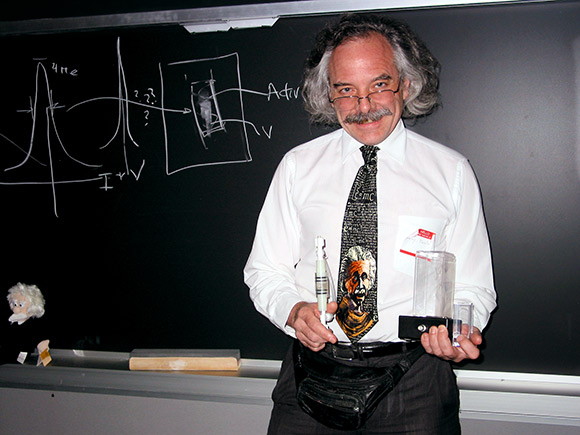Cold-Fusion Graybeards Keep the Research Coming

Photo: Courtesy of Mark Anderson
Despite a backdrop of meager funding and career-killing derision from mainstream scientists and engineers, cold fusion is anything but a dead field of research. Presenters at the MIT event estimated that 3,000 published studies from scientists around the world have contributed to the growing canon of evidence suggesting that small but promising amounts of energy can be generated using the infamous tabletop apparatus.
How reproducible the experiments might be, however, and how the mysterious phenomenon works are still very much open to interpretation.
Demonstrating recent results of energetic radiation streaming from a running cold-fusion experiment, Lawrence Forsley of JWK Technologies in Annandale, Virginia, passed around samples of his group's experimental apparatus -- all of which could be packed into a shoebox with room to spare. The compact plastic and rubber tubing illustrate the intrinsic paradox of this field: Compared to the warehouses worth of billion-dollar gadgetry needed to run "hot fusion," cold fusion research is cheap to fund. And yet cash is the primary limiting factor holding the research back.
The scarcity of funding -- and of young blood -- may testify to the discredited nature of the field, but the "greybeards" (as one presenter jokingly referred to his colleagues) keep turning up new results.
Scientists at the U.S. Navy's Space and Naval Warfare Systems Center, or SPAWAR, in San Diego performed the work Forsley presented, which was published in June in the German journal Die Naturwissenschaften. It joins a long list of cold-fusion research papers that many scientists now reflexively write off as junk.
Even some of cold fusion's top proponents are cautious when talking about the science.
"Should people believe in cold fusion based on the SPAWAR experiments (alone)? Probably not," said MIT's Peter Hagelstein, a co-sponsor of the conference, in an interview. "But ... that's not how science works. In the cold-fusion business, a very large number of experiments done by a large number of laboratories over a large number of years have contributed to a knowledge base. And (the SPAWAR) experiments potentially tell you something about what's going on inside, if we can get a confirmation that they're right."
The cold-fusion story began in March 1989, when two scientists from the University of Utah reported they had integrated an isotope of hydrogen (.pdf) called "deuterium" into a palladium rod and, running electrical currents through it, produced nuclear fusion in a jar. Several leading researchers around the United States, however, failed to replicate the results and soon pronounced cold fusion debunked, kicking the entire field to the sidelines of mainstream research.
Today's understanding of nuclear fusion, which involves the synthesis of two hydrogens to make one helium in an energy-creating reaction, doesn't allow for the type of reaction reported in 1989. The only proven recipe to make helium out of two deuteriums requires re-creating the conditions inside the nearest working fusion reactor: the sun.
Creating stellar temperatures and pressures inside a fusion reactor today requires more energy than the fusion reactions give back. In striking contrast to the standard CF tabletop equipment, construction of the world's most promising conventional fusion reactor, the $12.1 billion ITER in Cadarache, France, is expected to begin next year. It will take eight years to complete, and with it scientists hope to see commercial fusion power by 2040.
MIT's Peter Hagelstein, on the other hand, said "cold fusion" reactions have yielded surplus energy from as far back as the initial experiments in 1989. Verification of these controversial results is not the problem -- many labs around the world have reproduced parts of the results many times.
Instead, the damning element has been caprice.
"Excess energy comes in bursts in these experiments," said Hagelstein. "The effect has been observed in many other laboratories. It's also not been observed in other laboratories, especially in the early days."
Hagelstein's co-host, physician and electrical engineer Mitchell Swartz, reported his continued refinement of his own cold-fusion experiments, which he publicly displayed in operation over seven days at MIT in 2003.
"We have been running these (experiments) for so long," Swartz told the audience, "that the question now is not just can we (generate) excess heat, it's can we get a kilowatt? Can we get a small car moving on this stuff?"
Robert Weber, managing director of the Watertown, Massachusetts-based consulting firm Strategy Kinetics, has worked with startup technologies and says cold fusion is in a bind in the United States today. Researchers need at least $50 to $100 million in seed money, he said, to fully test its viability and commercial applications, if any.
With research budgets around the world primarily funding "hot fusion" research, the burden falls to angel investors, corporations (such as Mitsubishi, which has funded cold fusion experiments) and a few countries (such as Japan, China, South Korea and Israel) willing to venture into cold fusion's murky waters.
"If you look at the long tail of innovation, new technologies from the first disclosure to commercialization," Weber said, "it can take 20 years. So we're getting there."
Johnanne Winchester, a member of the development committee for the United Nations' International Year of Planet Earth, said she hopes to appeal to dot-com multi-millionaires and billionaires to help bridge the funding gap.
"I'm interested in helping (create) a renaissance in cold fusion … in rebranding it and getting the word out that it's alive and well and amazing things are happening," she said.
© 2007 CondéNet, Inc. All rights reserved. To subscribe or visit go to: http://www.wired.com